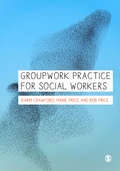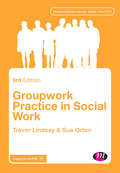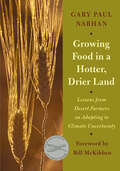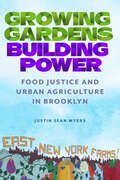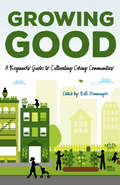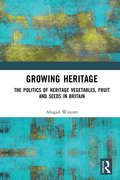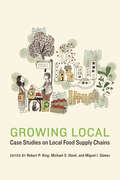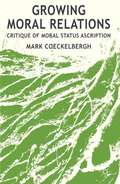- Table View
- List View
Group-Centered Prevention Programs for At-Risk Students
by Elaine Clanton HarpineMeeting the complex needs of at-risk students is a daunting challenge. One solution is to implement a school-based mental health approach that combines learning and counseling. This book focuses on how to implement a week-long integrated program of this kind.
Groups That Work: Structure and Process
by Paul Ephross Thomas VassilSocial workers, planners, health professionals, and human-service administrators spend much of their time in meetings, working in and with groups. What meaning does participation in these groups have for members? Some of the events that are most important for members of the various professions, and those whom they serve, take place within these groups. Health and human services depend upon their working groups for their development and allocation of resources, their standards of quality, and the evaluation of their success or failure. In short, these groups are relied upon to come up with creative solutions to complex problems. Despite the amount of time spent in meetings, committees, and so on, very little has been written about the skills necessary for effective participation and leadership within working groups. With that in mind, Ephross and Vassil combine innovative group theory and practice in this "how-to" guide for professionals who take a variety of roles within the group. They draw on examples from social agencies, a hospital, a low-income community, and the boardroom, providing practical principles for day-to-day group life based on a democratic model. This revised edition also explores the changes that have taken place in the structure and operation of working groups in recent years and the heightened expectations for groups within large organizations.
Groups in Community and Agency Settings (Group Work Practice Kit)
by Niloufer M. Merchant Carole J. YozampA practical guide to group work in community and agency settings Group work is becoming commonplace in a variety of community settings, including sexual assault centers, mental health centers, battered women’s shelters, chemical dependency units, community planning, employee training and development, employee assistance centers, and in other outpatient, inpatient, and residential settings. This accessible book: Demonstrates how the full range of group work, from remedial through preventive groups, is manifested in an array of community settings Provides practical, concrete information about how group work is being used and can be used even more effectively Draws on an up-to-date scholarly base that includes the latest research on group work Highlights diversity and multicultural issues, as well as accreditation or specialty standards important to group work in community and agency settings Groups in Community and Agency Settings is part of the Group Work Practice Kit: Improving the Everyday Practice of Group Work, a collection of nine books each authored by scholars in the specific field of group work. To promote a consistent reading experience, the books in the collection conform to editor Robert K. Conyne’s outline. Designed to provide practitioners, instructors, students, and trainees with concrete direction for improving group work, the series provides thorough coverage of the entire span of group work practice. This book is endorsed by the Association for Specialists in Group Work.
Groups that Work: Structure and Process, Second Edition
by Ephross Paul H. Thomas V. VassilHealth and human services depend upon working groups for their development and allocation of resources, their standards of quality, and the evaluation of their success or failure. With that in mind, Ephross and Vassil combine innovative group theory and practice in this "how-to" guide for professionals. They draw on examples from social agencies, a hospital, a low-income community, and the boardroom, providing practical principles for day-to-day group life based on a democratic model.
Groups, Norms and Practices: Essays on Inferentialism and Collective Intentionality (Studies in the Philosophy of Sociality #13)
by Hans Bernhard Schmid Ladislav Koreň Preston Stovall Leo TownsendThis edited volume examines the relationship between collective intentionality and inferential theories of meaning. The book consists of three main sections. The first part contains essays demonstrating how researchers working on inferentialism and collective intentionality can learn from one another. The essays in the second part examine the dimensions along which philosophical and empirical research on human reasoning and collective intentionality can benefit from more cross-pollination. The final part consists of essays that offer a closer examination of themes from inferentialism and collective intentionality that arise in the work of Wilfrid Sellars. Groups, Norms and Practices provides a template for continuing an interdisciplinary program in philosophy and the sciences that aims to deepen our understanding of human rationality, language use, and sociality.
Groups, Rules and Legal Practice
by Rodrigo Eduardo Sánchez BrigidoEver since Hart´s The Concept of Law, legal philosophers agree that the practice of law-applying officials is a fundamental aspect of law. Yet there is a huge disagreement on the nature of this practice. Is it a conventional practice? Is it like the practice that takes place, more generally, when there is a social rule in a group? Does it share the nature of collective intentional action? The book explores the main responses to these questions, and claims that they fail on two main counts: current theories do not explain officials´ beliefs that they are under a duty qua members of an institution, and they do not explain officials´ disagreement about the content of these institutional duties. Based on a particular theory of collective action, the author elaborates then an account of certain institutions, and claims that the practice is an institutional practice of sorts. This would explain officials´ beliefs in institutional duties, and officials´ disagreement about those duties. The book should be of interest to legal philosophers, but also to those concerned with group and social action theories and, more generally, with the nature of institutions.
Groups: Fostering a Culture of Change (Group Work Practice Kit)
by Cheri L. Marmarosh Emily Carter Dunton Claudia AmendolaLearn to foster a group with positive group culture This brief, easy-to-understand book draws on the latest research on group work to identify group conditions that yield a positive group culture. Throughout the book, authors Cheri L. Marmarosh, Emily Carter Dunton, and Claudia Ammendola explain how to nurture, support, and promote these conditions while addressing coverage of diversity and multicultural issues. Accreditation or specialty standards enhance the book’s presentation. This book is part of the Group Work Practice Kit: Improving the Everyday Practice of Group Work, a collection of nine books each authored by scholars in the specific field of group work. To promote a consistent reading experience, the books in the collection conform to editor Robert K. Conyne’s outline. Designed to provide practitioners, instructors, students, and trainees with concrete direction for improving group work, the series provides thorough coverage of the entire span of group work practice. This book is endorsed by the Association for Specialists in Group Work.
Groupwork
by Allan BrownThis highly successful book on groupwork practice, first published in 1979, has become a standard introductory text on most social work training courses. It is very popular with social workers, whatever their agency setting, and is also used by health visitors, youth workers and the voluntary sector. This new enlarged and revised third edition includes two new additional chapters. The first of these addresses the issue of groupwork in day and residential centres where special kinds of group skills are required in addition to those already well established for fieldwork groups. The second new chapter attempts to understand the significance of race and gender in groupwork and to begin to develop a framework for anti-discriminatory practice. All key sections from previous editions have been retained and updated, while those on group composition, open groups, co-working and consultation have been extended and revised to give more comprehensive coverage. The bibliography has also been developed to include the most recent additions to the groupwork literature, including many articles from the journal Groupwork for which Allan Brown is co-editor.
Groupwork Practice for Social Workers
by Marie Price Karin Crawford Bob PriceWorking with families, carers, groups and communities is something all social work students must prepare for. Written to guide you through these varied and complex groupwork situations, this book explores the knowledge, skills and values required for groupwork practice. Divided into two parts, the first provides an understanding of groupwork, its concepts and contexts, while the second takes you step-by-step through groupwork practice, from planning and preparation, to starting out, facilitating and finally ending work with a group. Different service contexts including work with children, with users who have learning disabilities, in mental health settings, and more, are covered throughout the book, with case studies, activities and reflective opportunities helping you to understand the complexities of these contexts. This text is a comprehensive and contemporary guide to groupwork in social work today.
Groupwork Practice for Social Workers
by Marie Price Karin Crawford Bob PriceWorking with families, carers, groups and communities is something all social work students must prepare for. Written to guide them through these varied and complex groupwork situations, this book explores the knowledge, skills and values required for groupwork practice. Divided into two parts, the first provides students with an understanding of groupwork, its concepts and contexts, while the second takes the student step-by-step through groupwork practice, from planning and preparation, to starting out, facilitating and finally ending work with a group.
Groupwork Practice in Social Work
by Trevor Lindsay Sue OrtonBoth the new social work degree and Post-Qualifying Award in social work require that students are competent at working with groups and such skills are also valuable in interprofessional practice, partnership working and within the social care workforce. This accessible book introduces the practicalities of planning, establishing, facilitating and evaluating social work projects and contains common-sense guidance on setting up, facilitating and closing small helping, interprofessional and other groups. The reader is introduced to the relevant skills, stages and decisions in groupwork and guided through what to do when things seem to be going wrong.
Groupwork Practice in Social Work
by Trevor Lindsay Sue OrtonBoth the new social work degree and Post-Qualifying Award in social work require that students are competent at working with groups and such skills are also valuable in interprofessional practice, partnership working and within the social care workforce. This accessible book introduces the practicalities of planning, establishing, facilitating and evaluating social work projects and contains common-sense guidance on setting up, facilitating and closing small helping, interprofessional and other groups. The reader is introduced to the relevant skills, stages and decisions in groupwork and guided through what to do when things seem to be going wrong.
Groupwork Practice in Social Work (Transforming Social Work Practice Series)
by Trevor Lindsay Sue OrtonThe social work degree requires that students clearly demonstrate competence in working with groups. Many social work students will begin working with families, communities and organisations before they qualify and are regularly assessed on this groupwork practice through assignments and observation. Specialist skills are needed to cope in challenging groups and the authors look at how students can develop their existing skills to cope and respond to challenges. The practical focus of this book on planning, organising, facilitating and evaluating groupwork will help students to develop their skills and pass assessment, increasing confidence during placement groupwork activities. A practical and accessible textbook, Groupwork Practice in Social Work is essential reading to help students through their complex and challenging Groupwork assessments. Key updates: New material on working with service user groups New material for students who are being assessed in a group Updated case studies This book is in the Transforming Social Work Practice series. All books in the series are affordable, mapped to the Social Work Curriculum, practical with clear links between theory & practice and written to the Professional Capabilities Framework.
Groupwork With Children and Adolescents
by Ralph L Kolodny James A GarlandThis state-of-the-art information on social groupwork with children and youth provides theoretical guidelines and suggestions for practice. Each authoritative chapter represents a blending of old and new practice models and syntheses of various knowledge perspectives and emphasizes the subtlety and unpredictability of groupwork. Experts addresses the issues of getting groups started, adapting group programs to the needs of younger school-age children, and using group therapy with young abused and neglected girls. They also include specific observations about the psychic and social developmental characteristics of the age groupings as a guiding factor in choosing group models and intervention techniques. Topics discussed include aspects of group dynamics, group techniques, resistance, stages in group development, and developmental issues of group members.
Groupwork in Social Care: Planning and Setting Up Groups
by Julie PhillipsIn this extremely practical guide, Julie Phillips argues that preparation is the most important element in running successful groups, and explores the issues that practitioners should address. She demonstrates how to prepare effectively, drawing on eight extended case studies with a variety of groups ranging from a positive parenting group to an anger management group. She examines the initial decisions that must be made such as determining the size, purpose and goals of a group, and finding an appropriate meeting place. Anti-discriminatory practice, with an emphasis on power, race and gender issues, is highlighted as a fundamental consideration in planning a group. Phillips underpins her recommendations for practice with the theories behind groupwork and includes frameworks for analysing the effectiveness of group programmes. Groupwork in Social Care will be essential reading for students and qualified professionals working in the fields of occupational therapy, youth work, social work, probation and community mental health nursing.
Growing Artificial Societies: Social Science from the Bottom Up (Complex Adaptive Systems)
by Joshua M. Epstein Robert L. AxtellHow do social structures and group behaviors arise from the interaction of individuals? In this groundbreaking study, Joshua M. Epstein and Robert L. Axtell approach this age-old question with cutting-edge computer simulation techniques. Such fundamental collective behaviors as group formation, cultural transmission, combat, and trade are seen to "emerge" from the interaction of individual agents following simple local rules. <p><p> In their computer model, Epstein and Axtell begin the development of a "bottom up" social science. Their program, named Sugarscape, simulates the behavior of artificial people (agents) located on a landscape of a generalized resource (sugar). Agents are born onto the Sugarscape with a vision, a metabolism, a speed, and other genetic attributes. Their movement is governed by a simple local rule: "look around as far as you can; find the spot with the most sugar; go there and eat the sugar." Every time an agent moves, it burns sugar at an amount equal to its metabolic rate. Agents die if and when they burn up all their sugar. A remarkable range of social phenomena emerge. For example, when seasons are introduced, migration and hibernation can be observed. Agents are accumulating sugar at all times, so there is always a distribution of wealth. <p><p> Next, Epstein and Axtell attempt to grow a "proto-history" of civilization. It starts with agents scattered about a twin-peaked landscape; over time, there is self-organization into spatially segregated and culturally distinct "tribes" centered on the peaks of the Sugarscape. Population growth forces each tribe to disperse into the sugar lowlands between the mountains. There, the two tribes interact, engaging in combat and competing for cultural dominance, to produce complex social histories with violent expansionist phases, peaceful periods, and so on. The proto-history combines a number of ingredients, each of which generates insights of its own. One of these ingredients is sexual reproduction. In some runs, the population becomes thin, birth rates fall, and the population can crash. Alternatively, the agents may over-populate their environment, driving it into ecological collapse. <p><p> When Epstein and Axtell introduce a second resource (spice) to the Sugarscape and allow the agents to trade, an economic market emerges. The introduction of pollution resulting from resource-mining permits the study of economic markets in the presence of environmental factors. <p><p> This study is part of the 2050 Project, a joint venture of the Santa Fe Institute, the World Resources Institute, and the Brookings Institution. The project is an international effort to identify conditions for a sustainable global system in the middle of the next century and to design policy actions to help achieve such a system.
Growing Food in a Hotter, Drier Land: Lessons from Desert Farmers on Adapting to Climate Uncertainty
by Gary Paul NabhanHow to harvest water and nutrients, select drought-tolerant plants, and create natural diversityBecause climatic uncertainty has now become &“the new normal,&” many farmers, gardeners and orchard-keepers in North America are desperately seeking ways to adapt their food production to become more resilient in the face of such &“global weirding.&” This book draws upon the wisdom and technical knowledge from desert farming traditions all around the world to offer time-tried strategies for:Building greater moisture-holding capacity and nutrients in soilsProtecting fields from damaging winds, drought, and floodsHarvesting water from uplands to use in rain gardens and terraces filled with perennial cropsDelecting fruits, nuts, succulents, and herbaceous perennials that are best suited to warmer, drier climatesGary Paul Nabhan is one of the world&’s experts on the agricultural traditions of arid lands. For this book he has visited indigenous and traditional farmers in the Gobi Desert, the Arabian Peninsula, the Sahara Desert, and Andalusia, as well as the Sonoran, Chihuahuan, and Painted deserts of North America, to learn firsthand their techniques and designs aimed at reducing heat and drought stress on orchards, fields, and dooryard gardens. This practical book also includes colorful &“parables from the field&” that exemplify how desert farmers think about increasing the carrying capacity and resilience of the lands and waters they steward. It is replete with detailed descriptions and diagrams of how to implement these desert-adapted practices in your own backyard, orchard, or farm.This unique book is useful not only for farmers and permaculturists in the arid reaches of the Southwest or other desert regions. Its techniques and prophetic vision for achieving food security in the face of climate change may well need to be implemented across most of North America over the next half-century, and are already applicable in most of the semiarid West, Great Plains, and the U.S. Southwest and adjacent regions of Mexico.Garden Writers Association Media Award, Silver Award for AchievementNew Mexico-Arizona Book Awards, Gardening Category"All of Gary Nabhan's books carry us on deep, enchanting journeys to the hearts of people, plants, and cultures across the world. . . I'm inspired and heartened by this timely and important offering from a true desert sage.&”—Toby Hemenway, author of Gaia's Garden: A Guide to Home-Scale Permaculture
Growing Gardens, Building Power: Food Justice and Urban Agriculture in Brooklyn (Nature, Society, and Culture)
by Justin Sean MyersAcross the United States marginalized communities are organizing to address social, economic, and environmental inequities through building community food systems rooted in the principles of social justice. But how exactly are communities doing this work, why are residents tackling these issues through food, what are their successes, and what barriers are they encountering? This book dives into the heart of the food justice movement through an exploration of East New York Farms! (ENYF!), one of the oldest food justice organizations in Brooklyn, and one that emerged from a bottom-up asset-oriented development model. It details the food inequities the community faces and what produced them, how and why residents mobilized to turn vacant land into community gardens, and the struggles the organization has encountered as they worked to feed residents through urban farms and farmers markets. This book also discusses how through the politics of food justice, ENYF! has challenged the growth-oriented development politics of City Hall, opposed the neoliberalization of food politics, navigated the funding constraints of philanthropy and the welfare state, and opposed the entrance of a Walmart into their community. Through telling this story, Growing Gardens, Building Power offers insights into how the food justice movement is challenging the major structures and institutions that seek to curtail the transformative power of the food justice movement and its efforts to build a more just and sustainable world.
Growing Good: A Beginner's Guide to Cultivating Caring Communities
by Sally Carr John A. Elliott Shelley Dewig Kyle Kramer Wendy Bredhold Cris G. Hochwender Anna Jean Stratman William Hemminger Jes Pope Amy Rich R. Calvin Kimbrough Jr. Trisha Brown Yvonne Mans Kamela Jordan Jim PoyserAnger and hopelessness can overwhelm communities. So what can everyday people do to actually grow some good in their own hometown? Growing Good: A Beginner's Guide to Cultivating Caring Communities shows how ordinary people have transformed themselves into volunteers and activists. Centered mostly in the Midwest, this collection of essays brings together the stories of normal people who have rolled up their sleeves to make their community a better place by serving nonprofits such as Gleaner Food Bank in Indianapolis, Indiana; Migration and Refugee Services in Louisville, Kentucky; and Patchwork Central in Evansville, Indiana, along with national organizations like CASA. For instance, a teacher and his student started a native plant garden to help local insects thrive in a disused corner of their school property. A woman saw a billboard and was moved to become a voice for children in need. A professional photographer offered his services to people experiencing homelessness in order to help others witness their humanity. Editor Bill Hemminger also writes of his own extensive experience with community gardening to feed hungry neighbors. Filled with simple actions, clear steps, and useful lists, including how to care for and nurture your own inner peace and creativity, Growing Good will help readers of all ages plant seeds of hope and cultivate communities where everyone thrives.
Growing Heritage: The Politics of Heritage Vegetables, Fruit and Seeds in Britain
by Abigail WincottThis book is the first comprehensive critical analysis of the cultural politics of a new kind of British heritage discourse. Based on texts ranging from tweets to restaurant menus that tell the story of heritage vegetables, this book explores what it means to think about our food systems, and their future, through the lens of ‘heritage’. From town hall seed swaps to restaurant menus and coffee table books, it has become hard in recent years for consumers to avoid the idea of ‘heritage’ fruit and vegetables. The British counterpart of North American heirlooms, their varied colours, strange shapes and endearing names are charming. Yet their proponents claim far more for them, arguing it is vital that we safeguard our crop heritage for global food security, social justice and consumer choice. This book examines how heritage fruits and vegetables are adopted to subvert corporate food production and take food back into our own hands, while supermarkets are eagerly adding them to their luxury ranges. The book also discusses the practice of heritage seeds being stored in secure facilities where most of the world’s growers cannot reach them. Written in an accessible style, this book will appeal to those studying, and those interested in, food studies and food politics; heritage studies; geography and environmental studies; the sociology of consumption and cultural studies.
Growing Income Inequalities
by Joël Hellier Nathalie ChusseauThis book provides an up-to-date survey of existing economic literature on the dimensions of growing income inequalities in both advanced and emerging countries. The different explanations and dimensions of inequalities are addressed, particularly globalization, technical progress, in-work poverty, changes in labour market institutions, education and intergenerational mobility, growth and development. The nine chapters provide simplified models exploring each of these elements, and assess commonly accepted explanations and mechanisms.
Growing Local: Case Studies on Local Food Supply Chains (Our Sustainable Future)
by Michael S. Hand Robert P. King Miguel I. GomezIn an increasingly commercialized world, the demand for better quality, healthier food has given rise to one of the fastest growing segments of the U.S. food system: locally grown food. Many believe that “relocalization” of the food system will provide a range of public benefits, including lower carbon emissions, increased local economic activity, and closer connections between consumers, farmers, and communities. The structure of local food supply chains, however, may not always be capable of generating these perceived benefits.Growing Local reports the findings from a coordinated series of case studies designed to develop a deeper, more nuanced understanding of how local food products reach consumers and how local food supply chains compare with mainstream supermarket supply chains. To better understand how local food reaches the point of sale, Growing Local uses case study methods to rigorously compare local and mainstream supply chains for five products in five metropolitan areas along multiple social, economic, and environmental dimensions, highlighting areas of growth and potential barriers. Growing Local provides a foundation for a better understanding of the characteristics of local food production and emphasizes the realities of operating local food supply chains.
Growing Moral Relations
by Mark CoeckelberghNew scientific and technological developments challenge us to reconsider our moral world order. This book offers an original philosophical approach to this issue: it makes a distinctive contribution to the development of a relational approach to moral status by re-defining the problem in a social and phenomenological way.
Growing Old in America: New Perspectives on Old Age
by Beth B. Hess Elizabeth W. MarksonModern industrial societies are characterized by long-term declines in fertility and steady increases in life expectancy. Together, these trends result in an aging population. The United States is no exception; since 1969 the median age has risen from 29.4 to a projected 36.4 in the year 2000. This fourth edition of the standard reader on the sociology of aging has been completely revised, with 90 percent new material, to reflect new information and new issues in this rapidly developing field. Students and practicing professionals will find it a lively, accessible overview.
Growing Old in America: The Bland-Lee Lectures Delivered at Clark University
by David Hackett FischerA history of aging in America surveys and compares actualities and attitudes in the eighteenth, nineteenth, and twentieth centuries and suggests practical improvements on the current inadequate system of pensions, social security, medicare, and other programs.







